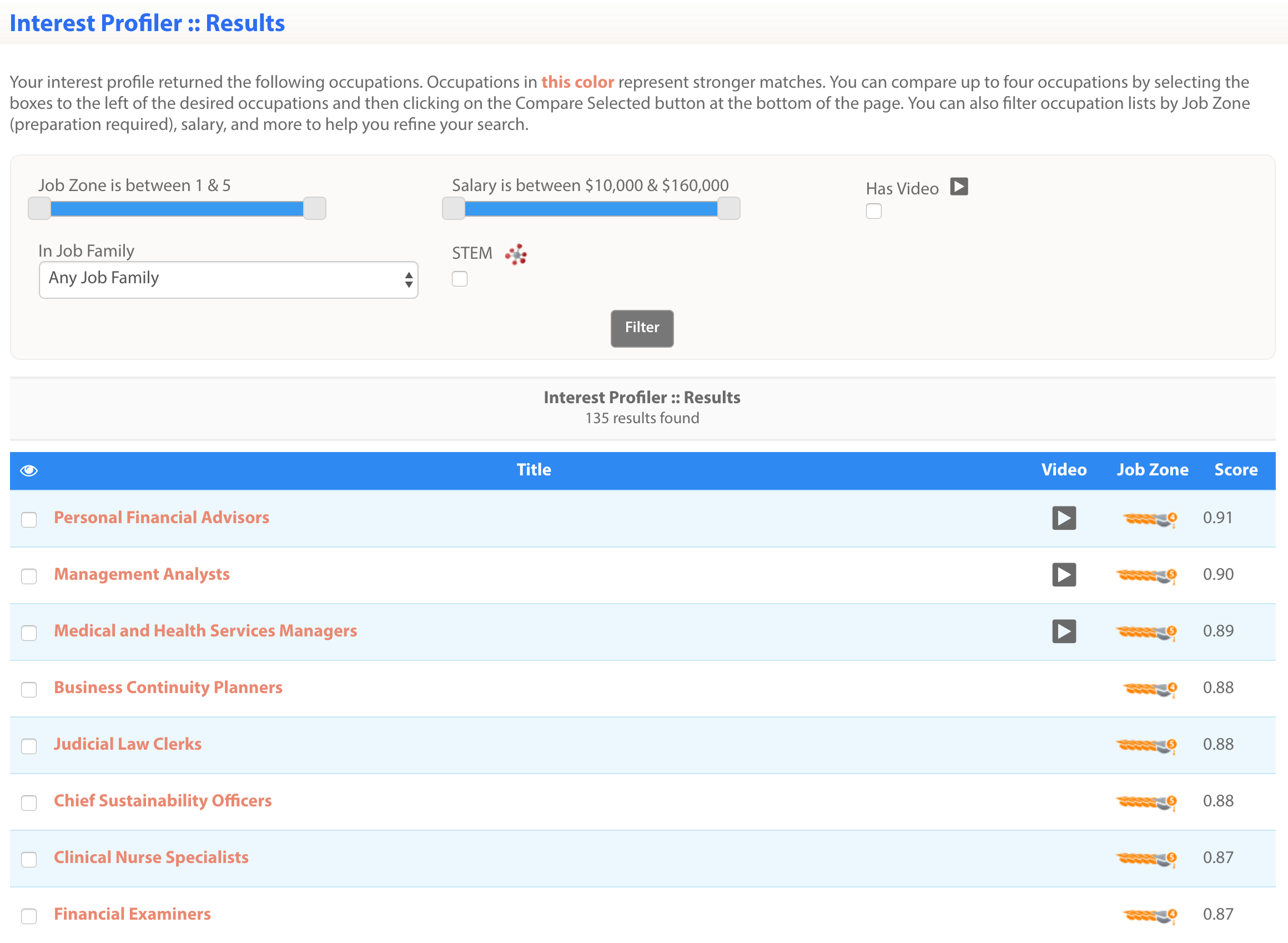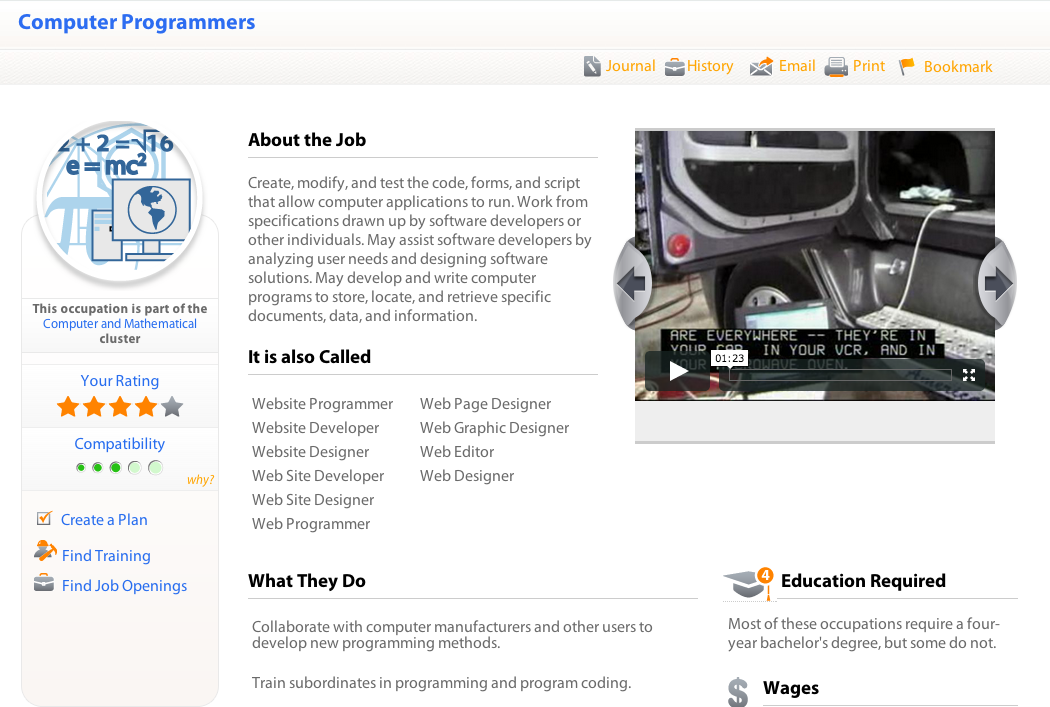Exploration
There are three ways to begin exploring:
- Taking an assessment
- Developing a budget
- Exploring by job titles
Each of these starting points will lead students to an occupational profile. Profiles are detailed information on occupations and include links to colleges and training needed for that occupation. We will discuss this in more detail later in this section.
Taking an Assessment
If your student choses to start with an assessment, ask your child to complete one of the three available assessments:
- The interest profiler which asks a series of questions about activities that might interest them
- The work importance profiler asks students to rank a series of statements about what they value in a job
- The skills profiler which asks students to identify their level of proficiency for each of twenty-four skill statements
TIP: We recommend the interest profiler as a good starting point especially if your student has little or no work experience. Each of the three assessments takes between 15-20 minutes to complete. Once your student answers the questions, each assessment returns a list of occupations to explore based on their answers.

Screenshot of an Occupational Listing
If 15-20 minutes is too long, students can take the Quick Assessment which will ask them to read descriptions of six broad occupational characteristics (realistic, investigative, artistic, social, enterprising, or conventional) and select their top three. The Quick Assessment doesn't provide as thorough a picture as the interest profiler, but will help them get started. The results of the Quick Assessment are not saved in your student’s account, but, as with the other assessments, students receive a list of occupations to explore, this time based on the three characteristics they selected.
Developing a Budget
Choosing to begin with a budget allows students to think about the lifestyle they want - what type of house, car, clothes, etc... Based on their choices, students will be presented a monthly cost of living and a minimum annual salary (inclusive of taxes) required to support that lifestyle. CareerZone will then suggest occupations that can provide that salary.
Exploring by Job Titles
If you student has an idea of what occupations interest them, they can go directly to the occupations and start searching by job title. Students can search by a job title, or browse by clusters of related occupations in an industry.
All three starting points will end up at occupational profiles. These profile pages are one of the central pieces to Headed2 CareerExplorer. On a profile page, you can view information on what people in that occupation do, what skills and knowledge they need, how much they make and even whether the occupation is expected to grow over the next few years. If the occupation is worth pursuing, you can find colleges to prepare your child as well as apprenticeship opportunities. If your child is already qualified, the find jobs button will show job openings for that occupation.
Occupational Profiles, Ratings and Compatibility
Each profile page has options to rate and bookmark that profile. When students rate a profile, their rating stays with the profile and appears each time that profile comes up. . Ratings also provide some weight to a student’s compatibility report, which we will cover shortly. Bookmarks indicate the student would like more information or wants to return for further exploration. Used together, ratings and bookmarks help determine which occupations to pursue and which to avoid.

Screenshot of an Occupational Profile
At the top of the page in the same line as the Ratings option, you'll find the Journal. The Journal allows students to save their questions and impressions about each job profile they see. A student can create as many Journals as they want to help them organize their thoughts. For example, have your student create a Journal for questions, one for impressions/ideas, and one for next steps. Then as they continue exploring, they can create entries in the appropriate Journal as thoughts arise. You can review their journals with them and answer questions or provide feedback.
Under Your Rating you will see a Compatibility score that is based on your student’s assessments, profile ratings, and exploration activities. The compatibility score estimates how well an occupation might fit your student and gives each occupation a score. On the occupation profile page, the score is represented as five circles—representing a range of mildly compatible to very compatible. Clicking on the circles will show the details about the exploration activities that lead to this rating.

Screenshot of an Occupational Compatibility Report
Creating a Plan
Once students have a line on an occupation, they can create a plan to help them with next steps. The plan is essentially a checklist of tasks that help guide the students through the next steps. As the student completes each item on the checklist, they mark the item as complete. If additional items arise, such as follow up research questions or other items they want to keep track of, they can add more items to the checklist.
Colleges
In addition to the occupational profile, the Headed2 CareerExplorer contains college profiles on over 7,000 institutions throughout the U.S. These college profiles work the same way as the occupational profiles work but focus on colleges, not occupations.

Screenshot of an College Profile
For any college shown in Headed2 CareerExplorer, there is a great feature called “What will it cost?” Using “What will it cost” allows students to figure out how much a particular college might cost, the potential amount of student loans needed to graduate, and compare these costs to potential earnings for a given occupation. This gives you and your student valuable information for planning for college. While costs are an important factor in deciding between colleges or universities, it is not the most important factor in deciding which college to attend.
Summarizing Everything
Have your print out their Summary report for review. This report shows an overview of all of your student's activities, including a combined list of the assessment results. This summary is a useful blueprint for further exploration and discussion, which we will cover in the next section.
